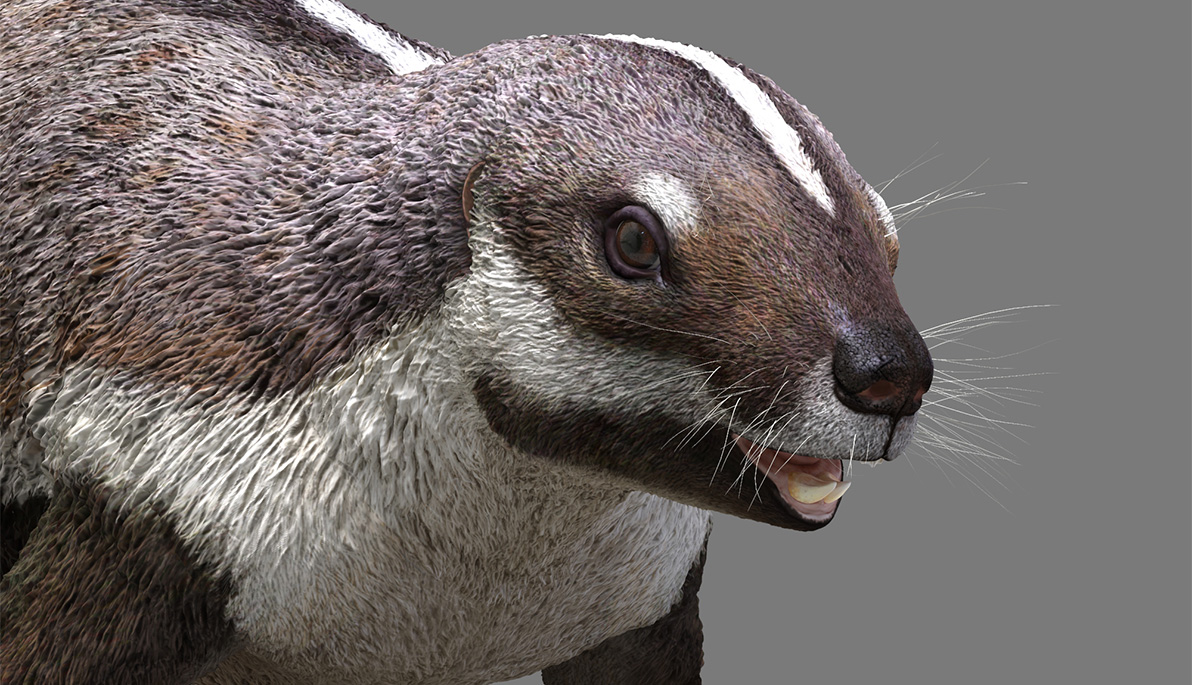News
Prehistoric “Crazy Beast” Unlocks an Evolutionary Mystery
April 29, 2020
Pictured: Fabricated model of the prehistoric possum-sized mammal Adalatherium, based on the nearly complete fossilized remains found by Simone Hoffmann, Ph.D., and other researchers in Madagascar.
An international team of researchers, including Simone Hoffmann, Ph.D., assistant professor of anatomy at NYIT College of Osteopathic Medicine, have uncovered a puzzling discovery: the remains of a prehistoric, possum-sized mammal from Madagascar.
Dubbed Adalatherium (translated from the Malagasy and Greek terms for “crazy beast”), the fossilized skeleton is nearly complete, unlocking clues on a creature that lived among dinosaurs and massive crocodiles 66 million years ago. Published today in Nature, the discovery is outlined by a team of researchers led by David Krause, Ph.D., a curator at the Denver Museum of Nature and Science.
Much like Australia, which is known for its unique flora and fauna, the island of Madagascar also has an array of unusual animals and plants that evolved in isolation over millions of years. This isolated evolution has resulted in both living and extinct creatures, like Adalatherium, that are unlike any others on the planet.
Adalatherium belongs to an extinct group of mammals called Gondwanatheria, which are only known to have lived on the ancient southern supercontinent of Gondwana. Gondwanatherians were first thought to be related to today’s sloths, anteaters, and armadillos, but according to Krause, are “now known to have been part of a grand evolutionary experiment doing their own thing, an experiment that failed and was snuffed out in the Eocene, about 45 million years ago.”
“Adalatherium is one of the most complete fossil mammals from the Mesozoic of the southern hemisphere, and provides new insights on the diversity and bizarreness of mammals that lived during the time of dinosaurs,” said Hoffmann. “Adalatherium was the size of an opossum, small by today’s standards, but a giant when compared to other Mesozoic mammals, most of which were the size of today’s mice.”
Research Team
Other researchers involved in the project (as listed on the research paper) include: Yaoming Hu (Stony Brook University, U.S.A.), John Wible (Carnegie Museum of Natural History, U.S.A.), Guillermo Rougier (University of Louisville, U.S.A.), Christopher Kirk (University of Texas at Austin, U.S.A.), Joseph Groenke (Ohio University, U.S.A.), Raymond Rogers, Macalester College, U.S.A.), James Rossie (Stony Brook University, U.S.A.), Julia Schultz (Universität Bonn, Germany), Alistair Evans (Monash University, Australia), Wighart von Koenigswald (Universität Bonn, Germany), Lydia Rahantarisoa (Université d’Antananarivo, Madagascar).
Unlike the fossil record of the northern hemisphere, much of the southern hemisphere’s fossils remain to be discovered and documented. Prior to the discovery of Adalatherium’s nearly complete skeleton, fossils of Gondwanatherians were only known from isolated teeth and jaw fragments, with the exception of a skull from Madagascar, which Krause, Hoffmann, and the rest of their team described in 2014. Now, Adalatherium could provide significant clues on what Gondwanatherians looked like and how they lived. Yet, the creature’s unusual features, including its snout, limbs, and teeth, still leave a great deal of mystery.
“Compared to any other mammal we have seen, it appears that Adalatherium had more passageways for nerves and blood vessels in its snout, suggesting that the creature had a sensitive nose covered with whiskers,” said Hoffmann. “Perhaps most strange is the singular large hole on the top of its snout, which is unlike anything we’ve ever seen in any living or extinct mammal, and remains to be explained.” In addition, the creature’s locomotive patterns remain a mystery. The scientists believe that while its muscular hind legs may have made Adalatherium a powerful digger (like badgers), its front legs were less brawny and are more similar to mammals today that can run fast. Notes Hoffmann, “Trying to figure out how it moved is difficult because its front end is telling us a different story than its back end.”
“Adalatherium is just one piece, but an important piece, in a very large puzzle on early mammalian evolution in the southern hemisphere,” Krause noted. “Unfortunately, most of the pieces are still missing.”
The researchers hope that Adalatherium will continue to unravel the mystery of Madagascar’s prehistoric creatures and their unique evolution.





